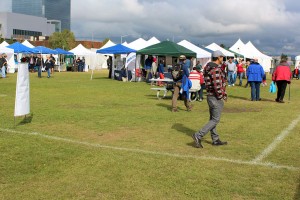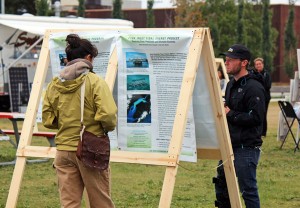Tidal power, wave, wind and solar: there’s no lack of options when it comes to renewable energy in Alaska. To participants at the Alaska Renewable Energy Fair on the Anchorage Park Strip last weekend, Alaska may be one of the best places on the planet to develop some of these ideas.

Renewable energy isn’t just about wind turbines and solar panels and biodiesel. It’s also, according to Renewable Energy Alaska Project executive director Chris Rose, about economics.
“The state of Alaska, cumulatively, all of us, we’re spending about 6 billion dollars a year on energy,” Rose says. “We have some of the highest energy costs in the country. So one of the advantages Alaska has in some ways is that we’ve got such high energy prices that we’re a great place to put in some of these emerging technologies, like tidal and wave, because we can save people money almost immediately.”
Rose says the Alaska Renewable Energy Fair, which will celebrate its tenth anniversary next year, is a way to get people to think about all that — about energy consumption and energy costs, no matter the source.

“The event is an opportunity for Alaskans to come and learn about energy,” Rose says. “It’s not just renewable energy, but where does energy come from? The implications of all our energy systems and our choices. Of course, we really focus a lot on renewable energy and energy efficiency, since that’s what we’re promoting and educating people about, but really, we’re trying to give people context for all of the energy decisions that they make.”
Energy efficiency is one of the things that Chugach Electric has in mind for its customers. Kate McKeown is the energy efficiency and conservation specialist with Chugach Electric. She says they’ve launched several online tools and a Facebook app that lets people measure their energy use and access information about how to reduce that use at home.
“Renewables are fun — you see that wind turbine, you see that solar panel,” says McKeown. “But energy efficiency is a little bit behind the scenes. So we’re trying to let people know that they could save money, which is very important, by doing very simple tips.”

These tips can be as simple as using fluorescent lightbulbs, cleaning out the dryer vent, or putting in windows with better insulation. People can also convert to using vegetable oil or biodiesel in their cars pretty easily, says Arctic VegWerks founder Will Taygan. Taygan teaches workshops around town as well as a class at Mat Su College.
“Biodiesel can be run in any vehicle with no modifications, no heating,” Taygan says. “You just need to chemically process the fuel to thin it out.”
And for Taygan’s car, a slight modification to the diesel engine means he can drive it on vegetable oil — straight from the deep fryer.
“This is a 1982 diesel Volkswagon campmobile,” he says, pointing to the brown van behind him, “and it has been running on pure vegetable oil all over the state all summer for fishing and hunting and playing.”

Taygan led a workshop on how to make biodiesel at Saturday’s event, along with many other workshops and updates on local energy projects. The Anchorage Landfill Gas-to-Energy project, for instance, uses methane from the Anchorage Landfill to produce 5.6 megawatts of power for Joint Base Elmendorf Richardson, or about 25 percent of the base’s electricity.
And, Chris Rose says, the tidal energy projects being explored right now in the Cook Inlet could be some of the most promising developments in Alaska.
“Alaska’s got 90 percent of all of the country’s tidal power potential, and 50 percent of the country’s wave power potential. So if anyone’s going to be a leader, it should be Alaska.”
There is a lot of potential. And combining lots of energy sources — from fossil fuels to vegetable fuels — is one way to bring costs down and keep energy up.




